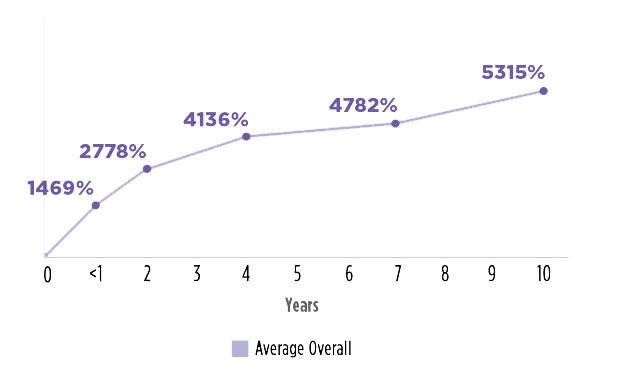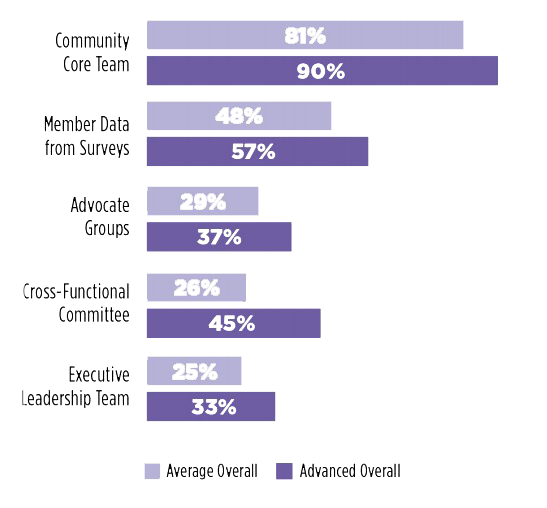


360Alumni
December 3, 2020
A strong community around a shared purpose generates innovation. It disseminates ideas, propagates connection, and garners opportunity.
Never has creating a community seemed so important, and serendipitously, so simple as it is today. With myriad services available designed purely to help attain this goal, community building is open to even the smallest of organizations, and yet some communities stall and stutter while others grow and flourish.
The Community Roundtable’s ‘State of the Community Management 2020’ report analyzes the success factors of the best performing communities. By understanding their findings we can all adapt our approach and grow together.
Without specific definitions, Community Roundtable uses ‘Advanced’ to describe those which demonstrate a higher level of commitment to advancing their community. One hallmark is the measurement of engagement and ability to implement changes based on resulting metrics.
Until recently, anecdotal evidence was the limit of community cost-benefit analysis. As community business models have emerged and developed the mission-critical ROI has become measurable. By monitoring communities which implemented such advanced strategies their successes can be isolated, tested, and replicated.
It goes without saying that communities which embrace an advanced model of online community development see the best ROI, with average cost per member lower as a result.
Comparison of ROI across internal and external standard and advanced communities

Financial return should never be the primary goal, and organizations which stay true to the original ethos of a community, embodying equitable, generative, sustainable, and innovative networks, fare best.
‘Advanced Online Communities’ tend to have a larger member base, yet are not necessarily more established. ROI is often lower in the initial years of developing a community (although as shown, averages 1,469% in year 1!), yet high implementation costs often drop significantly after the first year and stabilize to very low values after year 3 or 4 (ROI increasing to over 4,000% by year 4). The report suggests if investment in the community isn’t made early a stalling in growth can occur before reaching this generative inflection point. The key is perseverance and confidence in the process.
ROI increases in line with community maturity

Organizations with integrated systems tend to fare much better. This allows for communities to grow without limitation, removing complexity even as the member base increases. Online Alumni Software systems are a given, but also the integration of stakeholders into the process, creating a shared understanding of objectives, roles, and responsibilities. Working ‘less siloed’ means inclusion of ideas and input from other departments, lessening the burden and increasing the chance of community success. ‘Advanced Community’ programs tend to have significantly more cross-functional stakeholders involved in decision-making.
Comparison of involvement of stakeholders in decision
making between standard and advanced communities

Early engagement within online communities is often centered around the most passionate members given the less explicit value on offer to the masses. Early members tend to be motivated by community administrators and develop shared value for the community and accelerate growth. Identifying ambassadors to take the conversation forward or affinity groups where pockets of engagement can develop will grow the member base and help reach the ROI inflection point faster.
‘Advanced Online Communities’ create more value by enabling more ‘search and discover’ activity, leading to increased revenue. The more intrigue instilled in members by features of your platform and/or community and how that can transform into connection and value, the more they will offer in return.
Percentage of communities that have formal advocacy
and member leadership programs

Initial input and management of the community will invariably fall to the administrator, whose job it must be to provide truly valued content. Enticed and empowered by this, members will increase their level of contribution while the information relevancy and volume trends upwards too. If systems are in place that enable users to create their own events, chapter programs, groups, and content, the speed of community growth will accelerate exponentially.
Eventually a threshold is reached where user generated content, preferred by members, outweighs that by community administrators and community costs begin to reduce markedly. This then allows for investment to focus less on generating value and more on its curation.
Although curating is the end goal, a closed community with the right checks and balances is important. The safety of a community is governed by the administrator and a secured platform benefits members with the knowledge that moderators are active and have their best interests in mind.
One interesting byproduct of a successful community is how it can impact the organization positively by propelling change in interdepartmental and intraorganizational processes.
‘Advanced Communities’ are likely to report to senior executives more frequently than ‘Standard Communities’. 71% of ‘Advanced Community’ teams report to senior executives, and 54% do so weekly or monthly. Only 45% of ‘Standard Communities’ report to senior executives with only 41% doing so weekly or monthly. Engaging senior team members widens the understanding of the importance of communities and aligns everyone to the goal of growth and inclusion.
One of the limitations seen in ‘Standard Communities’ is the lack of a formal HR recognized position for community building. 61% of ‘Advanced Communities’ employ specifically for a role of community building, compared to 34% for ‘Standard’. When the burden falls on one person with other responsibilities it reduces the community leader’s ability to excel. Understanding the interplay of emotions, empowerment, and behaviors while crafting cultures that validate, encourage, and reward, as well as overseeing stakeholders, monitoring metrics, and leading growth, is a tall order.
Alongside personnel support, knowing funding is available and consistent is important too. ‘Advanced Communities’ are twice as likely to have funded roadmaps, a mature budget process, and have their budgets approved. Their funding success suggests that the ability to measure strategy is a key factor in securing the investment required to deliver it.
With all the additional features of an ‘Advanced Community’, the main differentiator to a ‘Standard Community’ is their ability to measure and adapt. Incremental success can be identified quickly and acted upon to gain extra funding and accelerate growth. ‘Advanced Communities’ pay less per member and gain more in return.
Percentage of Advanced Communities that can calculate community value,
and directly link to business outcomes.

As community creators we face many challenges, yet by looking to those who have stood before us and humbly learning from their strategic wins, we too can create connections that reach outward and lead our organizations forward.
360Alumni promotes all of the best practices of advanced communities. We are leaders in alumni online community software. Our client success team and our engagement and fundraising platform work hand in hand to help our clients get the ROI they seek from their community program. Contact us to learn more.